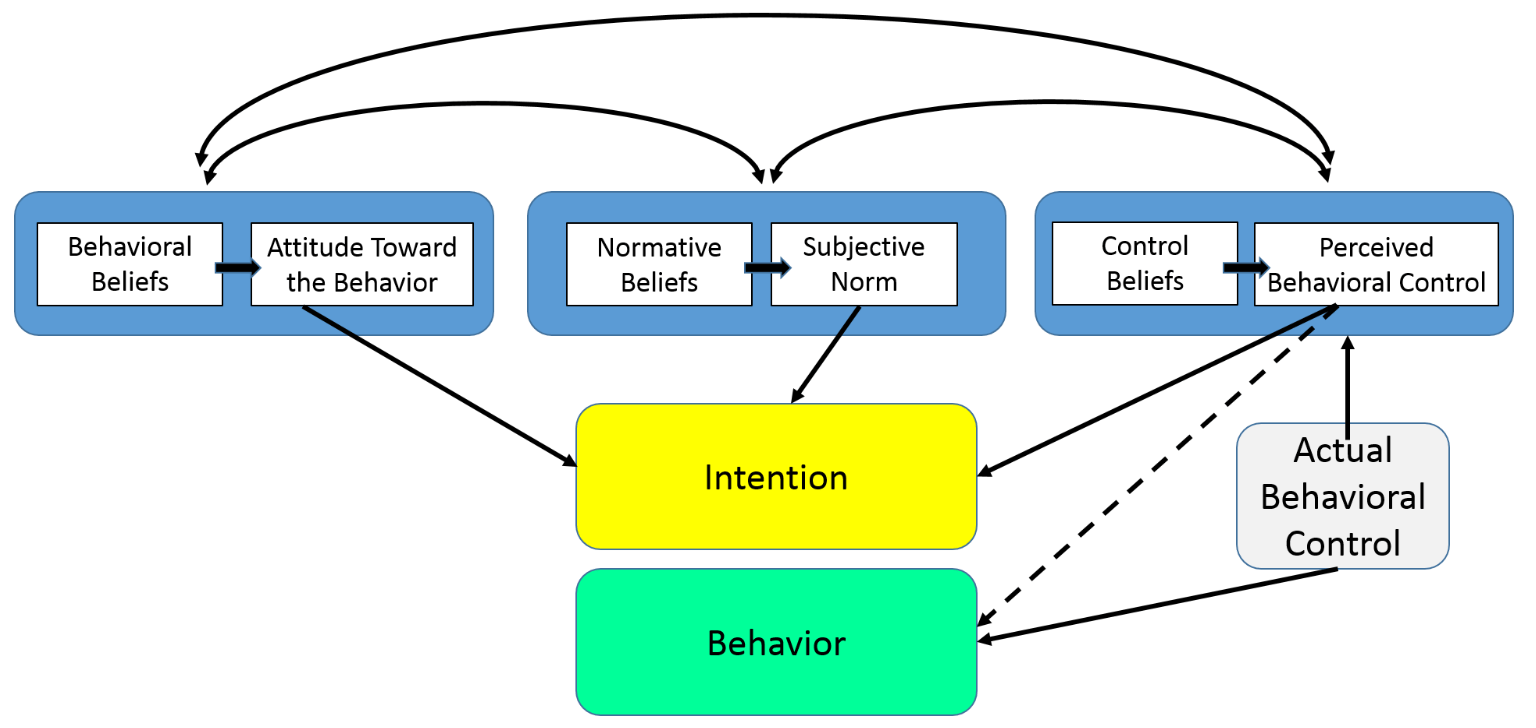
YOUR FITNESS BLOG
Creating Successful Behavior Change
Introduction
Behavior can be described as the actions created by an individual within theirselves or their environment [1, 2]. In the context of pursuing health and fitness goals, behaviors are more simply the strategies an individual employs to attain their objectives. As the far majority of people pursing health and fitness objectives focus on the outcome or end result (i.e. weight loss, improved strength and fitness, increasing muscle tone and definition), the behaviors an individual creates, and consistency within, ultimately determine achievement of the desired objectives. This post helps to clarify the role of behavior change in the context of health and fitness and offer suggestions for creating successful behavior change.
Behavioral Intentions
When an individual creates a goal (i.e weight loss, improved fitness), this goal is automatically reflective of specific behavioral intentions or necessitates the formation of behavioral intentions [4]. For example, an individual who maintains weight loss goals must first select behavioral categories to change (i.e. exercise, nutrition, general movement). In the context of nutrition, the behavioral intention could be to consume low-calorie dense foods. With respect to exercise, the behavioural intention could be to workout three times per week.
Behavioral theories highlight that behavioral intentions are precursors to behaviour [1, 4, 5]. Specifically, The Theory of Planned Behavior (TPB) developed to predict an individuals intent to engage in a behavior, states that behavioral intent directly precedes actual behaviour and is influenced by one’s attitude toward the behavior, subjective and social norms, and the perceived control an individual has over performing the selected behavior [1]. Essentially, the TPB model suggests that successful implementation of a desired behavior depends on both motivation (intent) and ability (control) [1, 5].
Setting Unrealistic Behaviours
As previously indicated, actual behaviors are preceded by behavioral intentions [1]. The creation of these intentions are common ground for setting unrealistic intentions that, in turn, can disrupt the behavior of interest. For example, within weight loss goals, important behavioral intentions fall within nutrition and creating a calorie deficit for weight reduction. In this example, it is common for individuals to set aggressive caloric reductions (i.e. 30%> calorie deficit) in an effort to accelerate weight loss. However, sustaining this degree of caloric deficit requires significant restriction of food intake. The implications of larger food restrictions can be failure to sustain this dietary intake over time.
Within exercise, unrealistic behavioral intentions are often set within frequency of exercise. For example, an individual goes from being relatively sedentary to creating the behavioral intention of exercising 4-5 times per week. This intended frequency of exercise can be unrealistic to sustain and result in failure to maintain the behavior longer-term.
An example of unsustainable behaviour change and the impact of aggressive behavioral intentions can be found in the television program “The Biggest Looser” [3]. Competing for weight loss, 16 overweight or obese, sedentary individuals were placed on 90 minutes per day of exercise, 6 days per week in addition to a calorie restricted diet. After the 30-week competition, subjects lost an average of 58Kg (128 lbs) [3]. Six-years following the show, with the exception of one subject, all had regained the majority of weight lost.
There were some definite physiological changes (i.e. metabolic adaptation) that occurred contributing to the subjects inability to keep the weight off [3]. However, there is also an important underlying behavioral component to this outcome. In an effort to maintain the weight lost during the show, these subjects would need to sustain the set behaviors (i.e. amount of exercise and dietary restriction) following the show. In fact, subjects would have needed to reduce their calorie intake even more to account for physiological changes, which slowed their metabolism as a result of the dramatic weight loss. As a consequence of setting unrealistic behaviors, the behaviors applied were too challenging for these subjects to sustain over the long-term.
Creating Successful Behaviors
As behavior change is highly individual, it is a complex process with no single solution for everyone. Within health and fitness objectives, it is often the case that an individual may need to cease or reshape an existing behavior (i.e. consuming less alcohol) [4]. It would be superficial to suggest that goal attainment within health and fitness is solely dependent upon behavioral changes. There is often a complex interaction of environmental, biological, cognitive and behavioral factors at play that influence goal attainment [8]. However, the focus of this article is centred on behavioral aspects. The following are three strategies that should be considered prior to creating behaviours for goal attainment:
1. Start with Understanding Values
An important starting point to prior to creating behaviors is understanding the values placed on them [4]. Values refer to the importance or worth an individual places on something [6]. Values are what direct goals and motivate behavior. Yet, unlike goals which have an end-point, values continue beyond when goals are achieved [4]. For example, the goal may be to lose 10kg because an individual wants to improve their self-image and increase self-confidence. However, the driving value in this example could be family and friends. Clarifying and outlining these values can help to motivate an individual to adhere to their selected behaviors.
If an individual values a behavior, or the goal this behavior will lead to, the individual is much more likely to persevere the behavior when it becomes challenging [2, 4, 6]. For example, an individual may value their physical health, therefore they attend workouts even when their schedule gets busy, because they know that their workouts are necessary to preserving their valued health. Likewise, an individual may decline engaging in multiple dinners out and drinks because they interpret forgoing these circumstances as necessary to maintaining control over their weight.
To initiate the process of clarifying and identifying values, one asks themselves what is the goal and why is the particular goal important to them? Then, in structured fashion, a chain is created linking the goal to he valued component [4].
2. Clearly Outline Behavior
An important component to creating successful behaviors is detailing the specific behavior. Specific behaviors are one’s that provide both clarity and precision for the goal setter [2, 6]. Unlike general behaviors, specific behaviors describe conditions for performance and can be observed and more objectively evaluated [6]. In the example below, the left column outlines that the specific conditions for performance will be daily nutrition tracking of food and beverages and the individual may select any food they wish within the specified caloric parameter. Successful completion of this specific behavior can also be evaluated via daily completion of nutrition tracking.
An individual who maintains the goal of losing 10kg creates what is called a performance goal [4, 6]. Performance goals can easily be tracked, however multiple behaviors may be required to reach this performance goal [4, 6]. For example, specific behaviors may need to be created within multiple behavioral categories (i.e. exercise, nutrition, general movement, sleep) [4].
3. Create Mastery Experiences
Most individuals pursuing health and fitness goals place all focus on the final outcome. For example, an individual with the performance goal of wanting to lose 10kg fixates on this final number to achieve. The issue with performance goals is they are often evaluated is terms of successes or failures [6]. Instead, focus should be placed on the process that leads to the outcome and a mindset that there are no failures, only welcome challenges that provide feedback for more effective solutions [4, 6, 7]. For example, the individual who wants to lose 10kg instead focusses on daily nutritional tracking. This individual may encounter challenges with tracking dinners and drinks out, but uses this challenge to implement caloric estimation strategies as a solution. Here the emphasis is placed on the specific behavior and working with the challenge encountered to develop a more effective solution.
When initiating a behavior, it is highly detrimental to be placed in a position of failure from the onset because of the complexity of a task [4]. Creating mastery experiences that reduce the difficulty of a task or behavior will allow an individual to succeed and may also help to build their self-efficacy and confidence [4, 7]. Mastery experiences shift focus away from the outcome and onto the process, reinforcing a mindset that failures do not exist, only challenges, and adopting a growth mindset that embraces challenges as opportunities for skill development [4, 7].
For example, setting the behavior of exercising 3-4 times for 60 minutes a week may be too challenging for an individual and may result in immediate failure [4]. Instead, aiming for 1 session per week of 45 minutes for the first 3 weeks may be help the individual succeed and therefore provide a mastery experience [4]. Once a mastery experience is achieved, the complexity of the task (i.e. moving to two, 45 minute sessions per week) may be increased.
Summary
In the context of health and fitness, behavior change refers to the action or set of actions an individual creates to attain their objectives. As the far majority of people fixate on the end goal or outcome, this approach and mindset deviates from what is important, that being the process and success of individual behaviors. Creating successful behaviors begins with setting realistic behavioral intentions. As a precursor to setting appropriate behavioural intentions, an individual should first consider the values they place on their behaviors, clearly outlining reasons why the selected goal is important to them. Once values are determined, creating specific behaviors that are clear, precise and can be more effectively evaluated are important for setting a plan and giving direction for goal attainment. Finally, reducing the difficulty of each behavior can help an individual build success in their journey through mastery experiences, which can further help build confidence in their abilities.
For more information on our services please click here to read more.
References:
[1] Ajzen, I. 2011. The Theory of Planned Behaviour: Reactions and Reflections. Psychology & Health. September. Vol. 26, No. 9, pp. 1113-1127.
[2] Bandura, A. 1977. Self-Efficacy: Toward a Unifying Theory of Behaviour Change. Psychological Review. March. Vol. 84, No. 2, pp.191-215
[3] Johannsen, D. L. et al. 2012. Metabolic Slowing with Massive Weight Loss Despite Preservation of Fat-Free Mass. The Journal of Clinical Endocrinology and Metabolism. July. Vol. 97. No. 7, pp. 2489-2496.
[4] Kompf., J. 2017. Complete Guide to Health Behaviour Change. Alan Aragon’s Research Review. July 2017. Pg. 1. Taken from: https://alanaragon.com/researchreview/.
[5] LaMorte, W. W. 2018. The Theory of Planned Behaviour. Boston University School of Public Health. Taken from: http://sphweb.bumc.bu.edu/otlt/MPH-Modules/SB/BehavioralChangeTheories/BehavioralChangeTheories3.html
[6] Locke, E. A. 2002. Building Practically Useful Theory of Goal Setting and Test Motivation: A 35-Year Odyssey. American Psychology. September. Vol. 57, No. 9, pp. 705-717.
[7] Mann, T. 2013. Self-regulation of Health Behaviour: Social Psychological Approaches to Goals Setting and Goal Striving. Health Psychology. May. Vol. 32, No. 5, pp. 487-498.
[8] Montesi, L. et al. 2016. Long-Term Weight Loss Maintenance for Obesity: A Multidisciplinary Approach. Diabetes, Metabolic Syndrome and Obesity. Vol. 9, Pg. 37-46.

Did you find this content valuable?
Add yourself to our community to be notified of future content.





